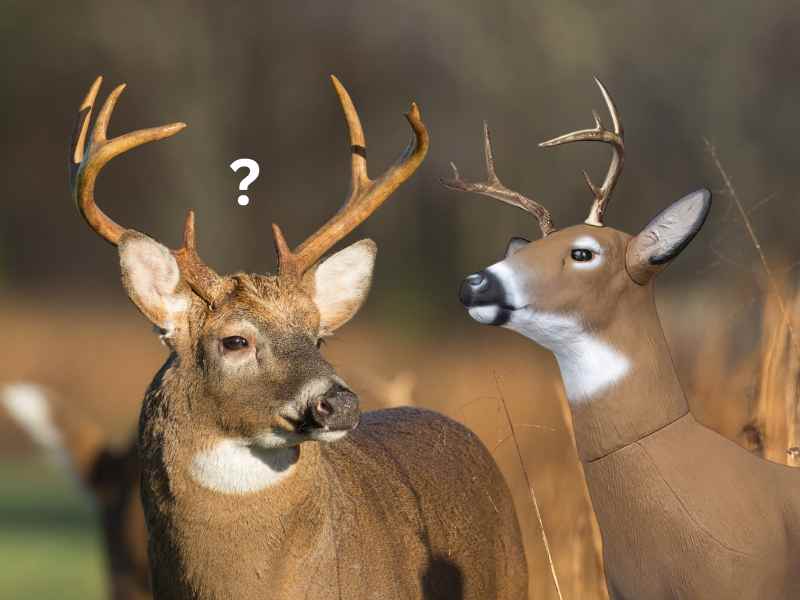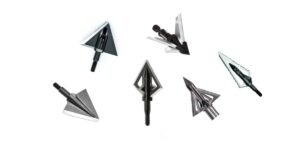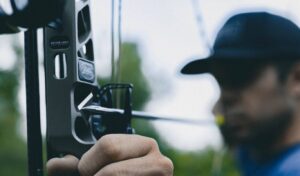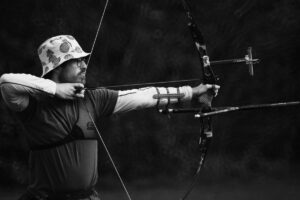Have you ever wondered about the best time to use a deer decoy? Understanding deer behavior and decoy use can significantly impact the success of your hunting experience.
Deer decoys are a popular tool hunters use to attract deer during hunting season.
To effectively utilize a deer decoy, you need to understand deer behavior and how to set up your decoy properly.
Let´s delve into the best strategies for using a deer decoy, including understanding deer behavior and setting up your decoy.
Contents (Jump to Topic)
ToggleUnderstanding Deer Decoys
The nuanced art of using a deer decoy revolves around timing and finesse. When played right, a decoy can lure in a trophy buck seeking dominance or companionship.
Yet, a poorly executed setup can easily turn the deer away.
You must assess whether a decoy aligns with your strategy for each situation.
Strategically placing a decoy is paramount.
For instance, setting a buck decoy at the field edge during the peak rut can entice mature bucks to investigate.
Conversely, when deer grow more cautious during the late season, decoys may lose their appeal.
Several factors ensure a decoy’s credibility to its live counterparts.
Scent control is top of the list; using rubber gloves to mask human scent and deploying deer or estrous scents near the decoy enhances realism.
Furthermore, the perfect spot often pairs with an ideal shot angle, providing a clear shot opportunity while considering safety.
A deer hunting endeavor may climax with a buck decoy drawing the attention of subordinate bucks or a trophy buck amidst the chasing phase.
Hunting on private lands may offer greater freedom for decoy setup, whereas, on public lands, extra regulations and hunting pressure can affect the decoy’s performance.
Choose your decoy moment wisely, considering the local buck population’s tendencies and the season’s temperament.
Deer Behavior and Decoy Use
Decoy hunting blends art with strategy, capitalizing on the deer’s instinctual behaviors.
Deer, widely known for their keen senses, are highly attuned to body language and the appearance of their conspecifics, making the realistic presentation of a decoy a pivotal component of its success.
Their extraordinary sense of smell adds an extra layer of complexity, as natural deer scents must be carefully applied to enhance the allure without alarming these astute creatures.
Hunters using decoys can expect a variety of reactions.
A decoy may infuriate some deer, causing them to charge, while others may circle, cautiously inspect, or even ignore the decoy.
Some deer may become startled by the decoy and flee. These varied responses make for electrifying moments in the field and can profoundly impact your success.
Deploying a decoy is a calculated risk, with a roughly 50/50 chance of eliciting a favorable reaction.
Understanding Deer Behavior
To effectively use a deer decoy, you must first comprehend the intricate dance of deer communications and behaviors, fluctuating with the hunting season phases.
During the pre-rut and peak rut, for instance, bucks exhibit elevated testosterone levels and a propensity for territoriality as they separate from bachelor groups.
They respond to competitors—real or decoy—with heightened aggression, marking this period as prime for decoy use.
The late season ushers in a more skittish and survival-focused demeanor among deer, often diminishing a decoy’s efficacy.
Weather conditions, time of day, and the presence of does also play crucial roles in shaping deer responses.
Hunters must observe and adapt to these patterns to select the optimal decoy deployment moment.
Just as important is the scent strategy; doe-in-heat scent can be irresistible if dispensed to mimic a natural trail (mishandling scents can alert deer to human presence and foil your efforts).
Using a Decoy to Attract Mature Bucks
Using a buck decoy shines most during the pre-rut and rut phases when mature bucks are more prone to aggressive behavior towards perceived rivals.
Positioning a buck decoy can instigate this instinct, giving you a prime shot opportunity.
Be careful when timing the introduction of the decoy.
To maximize a decoy’s potential, the setup location should accommodate the cautious nature of mature bucks, offering them a clear view.
Pairing this setup with authentic deer scents can be irresistible, compelling a dominant buck to investigate.
Private lands often afford the freedom to fine-tune this setup, compared to the regulations and hunting pressures found on public lands.
Subordinate Bucks and Yearlings

Younger bucks, comprised of subordinate and yearling individuals, are typically more curious and less wary than mature bucks.
Their inquisitive nature makes them prime candidates for decoy attraction.
Subordinate bucks and yearlings, in particular, may approach a decoy out of sheer curiosity or to size up the competition.
This behavior creates a dynamic tableau in the hunting ground that can indirectly draw the attention of a mature buck, thus expanding the impact of the decoy far beyond the initial interaction.
Deploying a decoy with subordinate or yearling bucks in mind involves less stratagem regarding territorial display.
These younger deer are less likely to engage in direct conflict with a buck decoy, though their curiosity can lead them into the hunter’s range.
For you watching from a distance, observing the behavior of these young bucks around a decoy can provide invaluable insight into local herd dynamics.
Setting Up Your Deer Decoy
When it’s time to add that extra edge to your deer hunting strategy, setting up a deer decoy can be a game-changer, especially when you aim to draw in that trophy buck.
It’s about strategic positioning, understanding deer behavior, and enhancing the setup with authentic scents.
Decoy Setup Tips
Positioning your deer decoy is critical to success.
Aim to place it in field corners or points where woods or grassland extend into open fields to maximize visual draw from distances, inviting bucks to venture within your shooting range.
Avoid tight spaces or areas with man-placed food sources during the rut, as this can spook deer.
Instead, place your decoy slightly off-center from the main deer trails to capture curiosity without triggering suspicion.
Consider the direction bucks will likely approach to ensure your decoy isn’t too close to your stand, preventing them from picking up unnecessary movement. And, of course, consider wind direction.
For the best shot opportunities, the decoy should be within a comfortable range of your position and on the opposite side from where the buck is expected to appear.
If you are right or left-handed, factor this in to anticipate and prepare for the ideal shot angle.
Using Scent to Enhance Decoy Attractiveness




Deer scent plays a pivotal role in lending authenticity to your decoy.
Estrous scents, where legal, are especially compelling during the chasing phase of the rut.
Position scent wicks to disseminate the aroma so that it drifts on the wind in the direction where you anticipate a buck to approach.
Refreshing the scent roughly every one to two hours keeps it potent, especially in less ideal weather conditions.
Always place scents upwind to avoid detecting human scent and increase the chances of drawing in a buck.
The strategic application of scents often makes the difference between a buck holding back and one that confidently strides into range.
Choosing the Ideal Spot for Your Decoy
Selecting the ideal spot for your decoy is about understanding where deer feel most comfortable and are likely to travel.
Field corners or areas where timber or grass protrudes into the field are excellent choices for visual appeal.
Bucks often utilize these natural corridors to enter fields and may be drawn to investigate a well-placed decoy.
Be mindful not to disrupt natural behavior by placing decoys near artificial food sources.
When setting up in or near food plots, position your decoy off the beaten path to keep doe groups undisturbed.
For doe decoys, food plots and agricultural fields make attractive settings, especially when trying to halt a migrating buck while searching for a mate.
The keys to setting up your deer decoy are strategic placement, realistic scent application, and careful location selection based on deer habitat and patterns.
Maximizing Your Deer Decoy Experience
Maximizing your deer decoy experience involves a combination of timing, scent control, and understanding deer behavior.
Knowing when to deploy your buck or doe decoy, depending on the phase of the rut, can mark the difference between success and an uneventful hunt.
With the peak rut as your ally, calling techniques, and a keen sense of managing scents efficiently, hunters can notably increase their chances of attracting their target.
Using a Buck Decoy During the Chasing Phase
The chasing phase of the rut is rife with opportunities to use a buck decoy to your advantage.
During this period, bucks are looking for does and are quick to challenge any perceived rivals.
- Employ realistic enhancements: Adding taxidermy eyes or fitting your decoy with an imposing antler set can ratchet up the true-to-life factor.
- Position it with intent: Placement in clear view with the potential for wind-driven scent dispersal is key.
- Monitor younger buck interactions: Not only do they offer entertainment, but they also serve as indicators for adjusting your decoy strategy.
- Utilize aggressive calling: Frequent calling and rattling complement the visual magnet of the decoy, potentially drawing in leery bucks from a distance.
Using a Doe Decoy During the Peak Rut
The peak rut is perhaps the best time to set up a doe decoy. Mimicking an estrous doe can be irresistible to bucks in full pursuit mode.
- Synchronous with natural cues: Deploy doe decoys when estrous scents are pervasive, aligning with late October and early November.
- Focus areas: Pinpoint where does bed and travel, and place your decoy accordingly for maximum encounter potential.
- Strategic scent application: A correctly employed estrous scent can be the clincher, drawing in bucks who might otherwise remain elusive.
- Patience and timing: Choose the right moment to deploy your doe decoy, as bucks can appear at any time, driven by their increased testosterone levels.
Decoy Use During the Late Season
Although the rut’s intensity has dwindled by the late season, hunters can still maximize their decoy use.
- Feeding areas and travel corridors: As bucks forage to replenish energy after the rut, savvy placement near these spots becomes crucial.
- Opt for subtlety: A feeding or bedded doe decoy can offer an unthreatening lure to weary bucks still looking for receptive does.
- Scent-wise: Heightened precautions with scents can mitigate the wariness of a mature buck.
- Embrace adaptability: Observe and react to buck behavior, as late-season patterns can shift significantly compared to the rut’s peak.
Before you Go…
Here you have it. Marrying strategic knowledge with a practical understanding of deer behavior and meticulous planning, using deer decoys can transform your hunting experience, opening up a world of dynamic and rewarding opportunities in the great outdoors.
Happy hunting!









